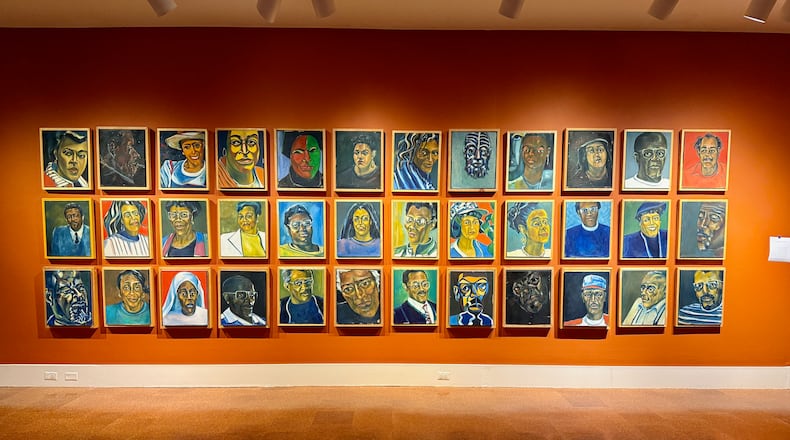Barnes, who passed away in 2019, was co-founder of the African American Visual Artists Guild and a highly regarded mentor to local artists.
He was a U.S. Air Force veteran, a Wright State University graduate, an educator in the Dayton Public Schools and a professor at Sinclair Community College. He was, at the core, a painter.
Credit: Contributed
Credit: Contributed
‘Curtis Barnes, Sr., Dayton Icon’
The Dayton Art Institute has opened an impressive retrospective of Barnes’s work in a special exhibition titled “Curtis Barnes, Sr., Dayton Icon” that celebrates the varied themes of his prolific output.
“This exhibition is both a celebration of his artistic vision and a reflection of the community that helped shape it,” said DAI Head Curator and Curatorial Affairs Director Jerry N. Smith.
“His work invites us to see the world through his eyes: layered with history, rooted in identity and always open to experimentation and interpretation.”
Working all hours from his basement art studio lovingly referred to as “The Tomb”, Barnes completed nearly a painting a day in his later years, often re-using canvases when he ran out of surfaces to work on.
He flowed with ease across genres including portraiture, still life, abstraction, non-objectivity and even architecture; his paintings emphasized color and texture and highlighted his Dayton neighborhood of Westwood.
His abstract works move in ripples of color with the rhythm of jazz, the music that often drifted up from The Tomb to greet family and friends for conversation and impromptu art lessons.
The walls of the exhibit have been painted in deep hues of eggplant, burgundy and terracotta to compliment Barnes’s rich palette. The warm tones welcome you into the space with the initial gallery offering a sampling of Barnes’s themes, including a self-portrait, a still life, and a mask painting.
He knew painting
Barnes held the modern masters in high esteem. He was self-taught in art history and in some of his work directly referenced painters including Cezanne and Picabia, while other artists wove their influence in more subtly.
Credit: Hannah Kasper
Credit: Hannah Kasper
Michael Goodson, who in 2021 launched the exhibit Zachary Armstrong: Grids and Abstracts alongside Curtis Barnes, Sr.: Love & Peace as then-curator of The Contemporary Dayton, immediately recognized the singular talent of Barnes.
“The thing I know now, after learning Curtis’s work, is that he knew painting. You can see it in the work, but he spoke of it too,” said Goodson.
Among his references Barnes mentioned Albrecht Durer, John Singer Sargent, Mark Rothko, Helen Frankenthaler and Richard Diebenkorn.
“The work speaks immediately to the history of Black painters leading up to Curtis — painters we all know like Romare Bearden, Jacob Lawrence and Alma Thomas. The work speaks (also) to Black painters more recently — Jean Michel Basquiat, Henry Taylor, and Lynette Yiadom-Boakye,” said Goodson.
“He was hungry to be an artist and a scholar, and he shaped his own contours in this regard.”
A symphony of color
A striking portrait in the DAI exhibit from 1979 titled “Sister Babalola (Mother Babalola)” illustrates the detail that Barnes was able to achieve even through layers of texture. The density of paint application in the sitter’s cheekbones begs you to reach out to the subject; it is filled with pathos. Areas are carved into, maybe with the end of a paintbrush. Geometric houses in the background allude to a close community. Momma Babalola, with her larger-than-life foregrounding, appears to watch over the neighborhood.
Credit: Hannah Kasper
Credit: Hannah Kasper
Artist Zachary Armstrong, who was close with both Barnes and his son, Curtis Barnes, Jr., described how the elder Barnes would forsake new paintbrushes for a certain well-worn one with just a few remaining bristles. Barnes would call it his “magic wand” and was able to achieve details like eyelashes with one confident swipe.
Armstrong said Barnes would hold his brush way back at the end of the handle, with his nose “3 feet from the canvas”. That confidence of touch is present in the paint handling. There are no neglected areas; the canvas is one holistic symphony of color.
“Untitled (Family Reunion)” is an example of visual rhythm that can be achieved through color mastery. It seems as though Barnes’s hand did not rest for too long in one spot, moving around fluidly. Look closely and the paint abstracts into dashes of color, back away from the canvas and you feel the crowd buzzing.
Credit: Hannah Kasper
Credit: Hannah Kasper
“One of the things I really took away from him and live by to this day was that there’s no difference between being an abstract painter and a figurative painter,” said Armstrong, who would sit and watch the painter work in his studio.
“It’s all the same. It’s all moving paint. Nothing that you put down on a canvas has been realized before.”
Gestures of humanity
Barnes’ works, even the most representational portraits, do not seem to have aimed for perfection. They are not meticulous in nature.
You can tell that some canvases were stretched later onto their frames, not quite as an afterthought, but also not as a priority. The frames are made with narrow lumber in a folk-like manner; some are smudged with paint.
These are not criticisms of quality; this is evidence of gestures of humanity. The imperfection conveys the immediacy with which the work was created. If no canvases were available, he would paint on cardboard or shipping crates.
Several of the pieces are untitled and undated. That precious bit of information that so many viewers glean to “solve” the mystery of the artwork, is not always there. According to Smith, this was no accident.
“When you give something a title, you’re pre-judging it for other people. You’re projecting something. He was very much wanting others to see what they see in it. There’s no wrong answer,” said Smith.
As for Barnes’s teaching style, Smith described it as similar to the work itself.
“He would cut the erasers off of pencils when teaching. There are no mistakes. You can work your way through any situation,” said Smith.
We wear the mask
Masks, sometimes in combination with portraits and sometimes as more isolated imagery, were a theme that appeared regularly over Barnes’s career. In the exhibit are references to Dayton poet Paul Laurence Dunbar’s famous poem “We Wear the Mask”.
“Around the 80s,” Barnes was quoted as saying, “I became fascinated with doing mask-related imagery after studying African art.”
Smith spoke of the poem in relation to the paintings.
“It speaks to the many false fronts people within an oppressed group must present to the world in order to hide one’s true self,” he said.
Credit: Contributed
Credit: Contributed
According to Barnes’s granddaughter, Brooke Goodwine, mask imagery served not just to conceal but also to represent “reflections of identity and protection”. Barnes was a family man, as evidenced through the many portraits of his relatives. Perhaps there is a thin line here between a portrait and a mask, to be both proud and protective.
“Westwood Community Portraits” is an eye-grabbing wall of 36 gridded portraits depicting individuals Barnes shared the neighborhood with for forty years.
“Seeing people born, people living, people getting older, generation after generation…it’s almost like a living, breathing history,” Barnes said in an essay on the Westwood portraits.
Some of his work referenced creation stories and mythology. He spoke often of “the cosmos” which would suggest a spiritual slant to some of the work.
“There are things in those paintings that, in various ways, speak to what is eternal and even mystical in great painting,” said Goodson.
Black Palette Art Gallery
Running concurrently with the DAI retrospective, the Black Palette Art Gallery is showing “Treasures from the Tomb, Celebrating the life and legacy of Curtis Barnes, Sr.”.
Organized by gallery owners Shola Odumade and James Pate, the intimate exhibit offers a personal glimpse into the artist’s world. The selection consists of pieces culled from the personal collections of the gallerists with a few works on loan from family and friends.
Odumade described the preparation of the show as a catharsis and a way to confront the grief surrounding the loss of both Barnes and his son, Curtis Barnes Jr., who passed in 2021 and was instrumental in pushing forward the legacy of his father’s art. He was also responsible for introducing Odumade and Pate, now married with a family.
Alongside the paintings at Black Palette are archival photos of Barnes at work in The Tomb, documented by Odumade over the years. There is also a framed palette, encrusted with thick layers of dried oil paint. It was a gift from Zachary Armstrong for Barnes’s 75th birthday. Here we catch a glimpse of Barnes’s personality — his palettes were repurposed Sinclair lunch trays. Use what you’ve got.
“The Tomb was a sacred space for discovery, conversation and creativity. We spent many New Years Eves down there. They would paint and music would be playing,” said Odumade, who curated the show.
Pate, a renowned local artist known for his figurative charcoal drawings, said that central to Barnes’s work is a sense of authenticity. Included in the show is one of Pate’s drawings, an impressive rendering of Barnes at work in The Tomb, alongside a photographic source.
Credit: Hannah Kasper
Credit: Hannah Kasper
“He was very brave as a painter, very confident. He would let that brush go. You can see that he didn’t pick over it. When I look at his work, I can see the ancestors. That intuitive power,” said Pate.
“These are literal treasures, artifacts — part of history. These are moments captured in time,” said Odumade.
“I hope that people can feel the personal aspect and intimacy of this exhibition experience and how it compliments the larger excitement that’s happening at the DAI.”
At his core, a painter
Armstrong reflected on his mentor, the man who inspired him to pursue life as a professional artist.
“It’s been 20 years since I’ve known his work, and I realize I was lucky that one of the first artists I knew happened to be one of the best painters I’ve ever seen in my life,” he said.
When Goodson was first introduced to Barnes’s work, it was a 1978 self-portrait that made a deep impression.
He reflected on the legacy of Curtis Barnes, Sr., and on that particular piece.
“The thing I knew when I looked at that painting was relatively straightforward: He was a great painter,” said Goodson.
“What I came to know was more complex: He was under-appreciated, but he still just kept painting, year after year, hundreds of paintings, in a basement on the west side of Dayton, Ohio. In the warm embrace of his family.
When I looked at that painting I knew Curtis Barnes was, at his core, a painter.”
HOW TO GO
‘CURTIS BARNES, SR., DAYTON ICON’ EXHIBIT
Where: Dayton Art Institute, 456 Belmonte Park Drive, Dayton
When: 11 a.m. to 5 p.m. Wednesday; 11 a.m. to 5 p.m. Friday and Saturday; noon to 5 p.m. Sunday and 11 a.m. to 8 p.m. Thursday. Through Sept. 14.
Admission: $15 for adults; $10 for seniors, active military, groups of 10 or more, college students and youth. Children ages 6 and younger and museum members are free.
More info: Special Exhibition Workshop Series — Everything is Everything: July 31 31, 5:30–8:30 p.m. Mixed media workshop led by artist Erin M. Smith Glenn. Cost: $100 for museum members; $125 for non-members.
BLACK PALETTE EXHIBIT
What: “Treasures from the Tomb, Celebrating the life and legacy of Curtis Barnes, Sr.”
Where: Black Palette Art Gallery, 1139 W. Third St. Dayton
When: 11 a.m. to 5 p.m. Tuesday through Saturday.
Admission: Free
More info: Instagram @blackpaletteartgallery
About the Author






